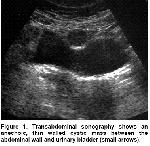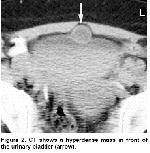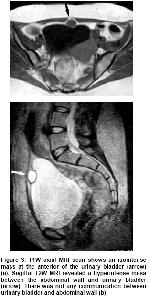In early fetal life, the allantois connects the urogenital sinus with the umbilicus. Normally, the allantois is obliterated during development and is replaced by a fibrous cord known as the urachus or median umbilical ligament. Failure of fibrous closure of the allantois results in a variety of urachal remnants. Incomplete obliteration of the urachal lumen results in the following five anomalies: congenital patent urachus, umblical urachal sinus, vesicourachal diverticulum, urachal cyst, alternating sinus
1. Urachal cysts are the most common type of urachal anomaly in adults
5.
Urachal cysts may present in many ways. Some have been discovered secondary to calcification of the cyst wall, calculus formation within the cyst, acute abdominal pain secondary to hemorrhage into cyst, intraabdominal rupture leading to peritonitis or spontaneous rupture without infection. Most urachal cysts develop in the lower third of the urachus due to epithelial desquamation and degeneration. Small urachal cysts are not uncommon and are often detected incidentally, unless infection or malignant change occurs 6.
Urachal tract remnants that abnormally remain patent are often subject to infection. Furthermore, these infected remnants are frequently confused with a wide spectrum of midline intraabdominal or pelvic inflammatory disorders at clinical examination and with malignant tumors at imaging 6. Depending on the variations in the patency of the urachal lumen, the drainage of infected fluid along the urachus can determine the acquired forms of umbilical-urachal sinus, vesicourachal diverticulum, or patent urachus or alternating sinus. Rarely, spontaneous rupture of an infected cyst into the abdominal cavity leads to localized or generalized peritonitis. Complex echogenicity at US and inhomogeneous attenuation with variable contrast enhancement in and around the disease process at CT make it difficult to differentiate an infected urachal remnant from urachal carcinoma. At CT, urachal carcinoma may be solid, cystic, or a combination of the two. Low-attenuation components are seen in 60% of cases, reflecting the mucin content 7. In our case cyst was homogenous, anechoic, not associated with infection or carcinoma.
CT or MRI is the preferred modalities for demonstration of an urachal cyst and possible secondary complications, such as tumor. Urachal diverticula may be seen at US, CT, MRI, intravenous urography or cystography. US examination and CT scan of the lower abdomen can be useful for diagnosing urachal cysts, especially for showing the relationship between the urachus and the bladder or umbilicus.
Urachal anomalies have been associated with other genitourinary conditions, such as hypospadias and crossed renal ectopia 8,9. The optimal diagnostic radiographic study depends on the presentation. A patient who presents with periumbilical drainage should have a sinogram performed, which should be diagnostic for both an urachal sinus and a patent urachus. Any child who presents with a periumbilical mass should be suspect for having an urachal cyst, and an US should be performed, which is usually diagnostic. Complete surgical excision of the urachal abnormality with a bladder cuff is recommended to avoid recurrence or development of carcinoma in unresected tissue 10.
In conclusion, urachal remnants are not exceptional and are symptomatic if complicated. US CT and MRI identify most diseases entities originating from urachal remnant. Treatment consists on total excision because there is a risk of malignant degeneration.





